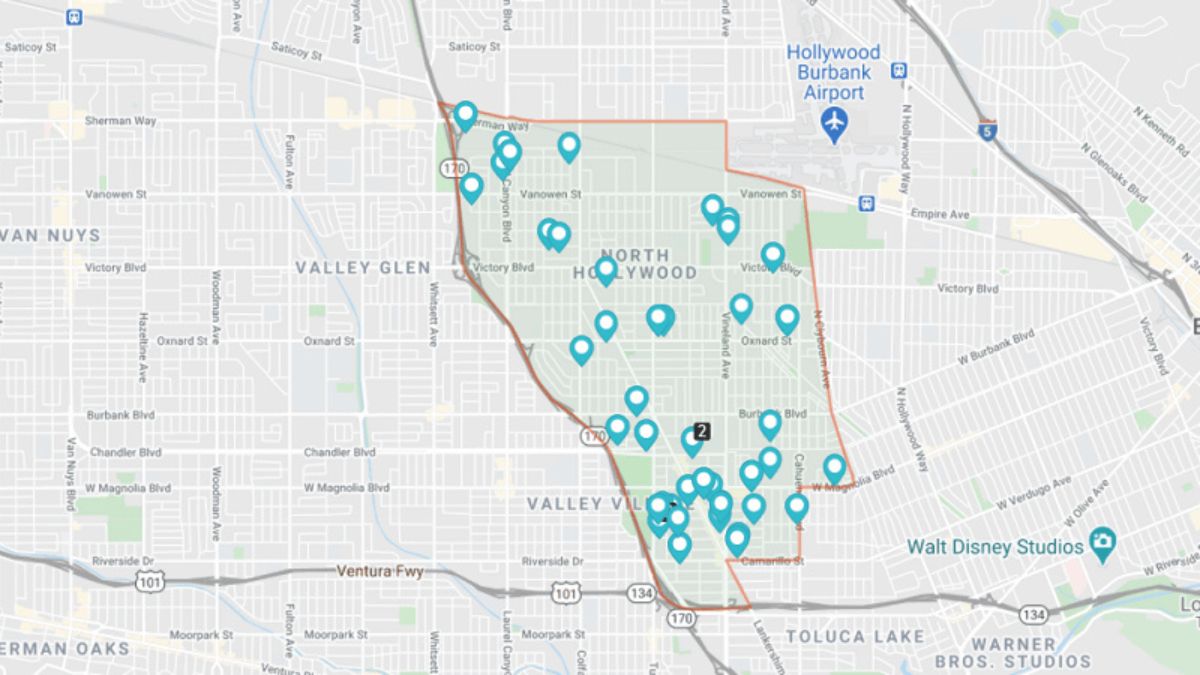TOPIC
North Hollywood Vs. West Hollywood: Which Neighborhood Is Right For You

Choosing the perfect neighborhood can feel overwhelming; after all, where you live will shape your daily life, from your commute to your social scene. That said, North Hollywood and West Hollywood are two vibrant areas in Los Angeles, each offering distinct vibes and opportunities.
But you may ask: North Hollywood vs. West Hollywood: Which neighborhood is right for you? This article explores the differences between these areas by breaking down key factors, like cost of living, safety, and job opportunities. By the end, you’ll have a clearer picture of which neighborhood best suits your lifestyle. Read on.
Location And Accessibility
North Hollywood and West Hollywood are both centrally located, making them desirable spots to live. However, their accessibility differs significantly, depending on your priorities.
North Hollywood is situated in the San Fernando Valley, offering easy access to major highways like the 101 and 170. It’s a commuter-friendly area with the Metro B Line (Red) directly connecting to Downtown LA. For those relying on public transit, this neighborhood is a practical choice.
West Hollywood, on the other hand, lies closer to central Los Angeles and iconic areas like Beverly Hills. Its walkability sets it apart, with most errands and entertainment options reachable on foot. Here, public transit options are decent but not as comprehensive as North Hollywood’s Metro lines.
Key points:
- North Hollywood: Ideal for commuters needing freeway access or Metro connectivity.
- West Hollywood: Great for those who prefer walkable neighborhoods with nearby attractions.
Cost Of Living
Living expenses are crucial when choosing between North Hollywood and West Hollywood. Here is a breakdown of the two places.
North Hollywood is more affordable overall. The average rent for a one-bedroom apartment here ranges from $2,000 to $2,500. Utilities and dining costs are also relatively budget-friendly, making it a practical option for those mindful of their finances.
West Hollywood, known for its upscale vibe, comes with a higher price tag. Rent for a one-bedroom apartment averages $2,800 to $3,500. Upscale restaurants, boutique shopping, and premium amenities contribute to the higher cost of living.
In summary:
- North Hollywood: Affordable rents and moderate living expenses.
- West Hollywood: Higher rents and luxury amenities.
Housing Options
Housing options in North Hollywood and West Hollywood cater to different needs. Here is a closer look.
North Hollywood offers a mix of affordable apartments, single-family homes, and modern developments. It’s a popular choice for renters, with many new apartment complexes featuring amenities like gyms and pools. For families, there are also reasonably priced houses.
West Hollywood, on the other hand, leans toward luxury housing. Upscale condos, chic apartment buildings, and historic homes define the real estate market. While the options are stunning, they come with a higher price tag, catering to those seeking a more premium living experience.
Housing highlights:
- North Hollywood: Affordable apartments and family-friendly houses.
- West Hollywood: High-end condos and stylish apartments.
Job Opportunities
Employment opportunities can make or break a neighborhood choice. Here’s how North Hollywood and West Hollywood compare.
North Hollywood benefits from its proximity to major studios like Universal and Warner Bros. It’s a hub for entertainment industry jobs and related fields. Additionally, its Metro access makes commuting to other parts of LA easier for work.
West Hollywood is home to thriving industries like fashion, media, and hospitality. It’s also a hotspot for entrepreneurs and small businesses. While job options are abundant, they often align with the neighborhood’s upscale nature.
Key takeaways:
- North Hollywood: Great for entertainment industry professionals.
- West Hollywood: Ideal for careers in fashion, media, and luxury services.
Entertainment And Dining
When it comes to entertainment and dining, both neighborhoods shine in their own ways.
North Hollywood offers a mix of casual eateries and cultural attractions. The NoHo Arts District is a gem, featuring theaters, comedy clubs, and art galleries. Dining options range from trendy cafes to international cuisine.
West Hollywood, however, is a mecca for nightlife and high-end dining. Michelin-starred restaurants, rooftop bars, and iconic music venues like The Troubadour make it a top destination for foodies and night owls.
Notable options:
- North Hollywood: Affordable dining, theaters, and art galleries.
- West Hollywood: Fine dining, nightlife, and music venues.
Safety And Crime Rates
Safety is a top concern for many when choosing a neighborhood. Here is an overview of how these areas compare.
North Hollywood has a moderate crime rate, with some areas being safer than others. Community efforts and police presence have improved safety, but it’s still essential to research specific streets.
West Hollywood generally boasts a lower crime rate. The city’s well-lit streets, active nightlife, and dedicated security measures have contributed to a safer environment. However, petty crimes like theft can still occur.
Outdoor Spaces And Recreation
Outdoor enthusiasts will find plenty to love in both neighborhoods. However, the offerings differ in scope and style.
North Hollywood features parks like North Hollywood Park and nearby hiking trails in the Hollywood Hills. These spaces are perfect for families, joggers, and dog owners.
West Hollywood boasts beautiful spots like West Hollywood Park and the Sunset Strip for urban strolls. While outdoor space is more limited, the vibe is stylish, catering to those who enjoy people-watching.
Outdoor highlights:
- North Hollywood: Spacious parks and hiking trails.
- West Hollywood: Stylish parks and urban scenery.
Community And Demographics
Understanding a neighborhood’s community is key to finding the right fit. Here’s how these two areas differ.
North Hollywood is diverse, attracting artists, students, and families. Its community-focused events, like art walks and farmers’ markets, foster a welcoming atmosphere. It’s an inclusive neighborhood with a relaxed vibe.
West Hollywood is equally diverse but leans toward a more upscale crowd. Known for its LGBTQ+ inclusivity, it hosts iconic events like LA Pride. The community is vibrant, fashionable, and socially active.
Community highlights:
- North Hollywood: Artistic, family-friendly, and community-oriented.
- West Hollywood: Upscale, inclusive, and event-focused.
Quality Of Education And Schools
For families or those pursuing education, schools are a critical factor. How do these areas compare?
North Hollywood offers a mix of public and private schools, with several highly rated options. Its proximity to universities like UCLA and CSUN makes it appealing to students.
Schools in West Hollywood are well-regarded, but the area’s focus is less family-oriented. Private schooling options dominate this neighborhood, catering to those who can afford premium education.
Education overview:
- North Hollywood: Great for public schools and proximity to universities.
- West Hollywood: High-quality private schools.
Takeaway: Which Neighborhood Is Right for You?
Deciding between North Hollywood and West Hollywood comes down to your lifestyle, budget, and priorities. North Hollywood appeals to those seeking affordability, artistic vibes, and convenient public transit. Meanwhile, West Hollywood caters to those who value luxury, nightlife, and a walkable environment.
Each neighborhood offers something special, making it important to weigh your options carefully. No matter your choice, both areas promise a vibrant experience in the heart of Los Angeles.
Ready to make the move? Partner with a reliable Moving Company in North Hollywood to ensure a smooth transition. Look for professionals who offer comprehensive services, from packing and transportation to unpacking and setup.
A reliable team can help you navigate the challenges of relocating, ensuring your belongings arrive safely and on time. With the right mover by your side, starting fresh in your new neighborhood will be seamless and stress-free.
TOPIC
Can You File a Claim If Road Conditions Caused Your Motorcycle Crash?

Motorcycle crashes impact lives. When poor road conditions cause these accidents, you may wonder about filing a claim. Understanding your rights helps you make informed decisions. Bad roads, such as those with potholes or debris, present unique challenges for riders. These hazards can lead to devastating outcomes. You may think, “Who is responsible?” That’s a fair question. State or local governments often manage road upkeep. If they neglect maintenance, they might be accountable. But proving this requires evidence and expertise. Consulting experienced professionals is crucial. Groth Law Accident Injury Attorneys is a trusted resource in such situations. They guide you through the legal process. Gathering evidence, such as photos or witness testimonies, strengthens your case. Awareness of these steps can protect your future. You deserve justice when harmed due to someone else’s negligence. Understand your options. Knowledge empowers you to seek rightful compensation. Let’s uncover what action you can take.
Your Legal Rights and Responsibilities
When faced with a motorcycle crash caused by poor road conditions, knowing your rights is the first step toward resolution. Do you have a claim? Yes, if negligence on the part of road maintenance entities contributed to the crash. It’s critical to determine if the government is responsible for the road’s condition. Understanding regulations helps you establish a claim. For instance, Federal Highway Administration provides guidelines on road maintenance. Knowing these can help you understand where negligence occurred.
Proving Negligence in Motorcycle Crashes
To succeed in a claim, you must prove negligence. This involves showing that the responsible party knew or should have known about the hazard. Gathering evidence is essential. You need clear proof that links the road condition to your crash. Photos, reports, and witness statements play a vital role. Document everything, including the location, time, and specific conditions of the road. These details create a strong foundation for your claim.
Steps to File a Claim
Filing a claim involves several steps. First, report the accident to authorities. Accurate police reports can aid your case. Then, seek medical attention. Health records not only ensure your well-being but also serve as evidence of your injuries. Afterward, consult legal experts. They guide you through the intricate legal process. Experts can help you notify the responsible government entity of your intent to file a claim. It’s important to meet all legal deadlines, as missing them can jeopardize your case.
Understanding Liability
Determining liability in these cases can be complex. The table below outlines possible responsible parties and their typical maintenance duties:
| Responsible Party | Typical Maintenance Duties | When Liability May Apply |
| Local Governments | Maintain city streets | When city roads are neglected |
| State Governments | Maintain highways | When highways have hazards |
| Federal Agencies | Oversee federal routes | When federal routes are unsafe |
Importance of Expert Guidance
Expert guidance is invaluable. Legal professionals understand the nuances of such claims. They assess your situation and offer advice tailored to your needs. With their help, you can navigate the complexities of the legal system. This support can be a significant relief, ensuring your rights are protected.
Taking Action
Act promptly. Time matters in these cases. Evidence can disappear, and legal deadlines can pass quickly. By acting swiftly, you preserve your rights and enhance your chances of success. Stay informed and proactive throughout the process. Your diligence can make a substantial difference in the outcome.
Conclusion
Motorcycle crashes are life-altering events. When poor road conditions cause these incidents, you have the right to seek justice. Proving negligence requires careful documentation and expert assistance. By understanding your rights and taking informed steps, you can pursue rightful compensation. Remember, you are not alone. There are resources and professionals ready to guide you through this challenging time. Your well-being and future matter. Take control and act today.
TOPIC
A Kidnapping Private Detective Shares 8 of the Top Reasons Kidnappers Choose to Kidnap Others

Kidnapping is a terrifying crime that can happen to anyone. Children and adults are often targeted. It is necessary to communicate with private investigators in OKC and process servers near me who have worked on multiple kidnapping cases. Their knowledge about kidnapping cases reveals the top hidden reasons for kidnappers. These expert professionals play an important role in solving complex cases like this.
The top 8 reasons kidnappers choose to kidnap others and how process servers in OKC and private investigators in OKC help victims seek justice are explained in this blog.
1. Ransom Money
Money is seen as the most common reason behind kidnapping. Kidnappers often target those who belong to wealthy families and business backgrounds, so they can have a large amount of money from the victims’ families. Private investigators in Oklahoma City are experts in tracking them and getting in communication to work with law enforcement for victims.
2. Personal Revenge
Kidnappers often kidnap people for personal conflicts instead of money. In such cases, people take revenge on others. It can be a partner, close friend or even a colleague. A private investigator in OKC can collect evidence and uncover the truth for justice.
3. Custody Battles
Sometimes, one parent can kidnap their child because of a custody battle, and it is known as parental kidnapping. These situations can be complicated if parents take their child outside the state. In such a situation, private investigators in Oklahoma work closely with high authorities to track kidnappers and return the child safely.
4. Human Trafficking
Human trafficking has been a major issue in the U.S., including in Oklahoma. Traffickers kidnap individuals and force them into exploitation. Quick responses from a process server in Oklahoma City can make all the difference and avoid court cases.
5. Mental Illness or Delusion
Not every kidnapper has a logic behind kidnapping. Some kidnappers have mental illnesses, and they believe it is a way to earn money from people who do not belong to them. These cases are extremely difficult and cannot be solved without the help of investigators near me who can handle complex situations.
6. Jealousy or Obsession
People who are jealous and obsessed kidnap others to gain control over them. A skilled private investigator and process server in OKC works with law enforcement to protect victims and uncover the truth.
7. Coercion or Leverage
People often kidnap others to pressure them. For example, a criminal kidnaps a business owner to get assets from them. In such high-profile cases, a process server in OK delivers legal documents to deal with the kidnappers and support victims.
8. Random Opportunity or Mistake
Some kidnappings are not planned. Some happen due to mistaken identities. Process servers and private investigators in Oklahoma City can interview witnesses and help with identifying the suspect.
Conclusion
People often get upset and emotional when they face the kidnapping of their loved ones. In such a complicated situation, it is necessary to find private investigators in OKC and a process server in Oklahoma who have experience in solving complex cases. These professionals are familiar with Oklahoma laws and work efficiently to gather evidence.
If you are searching for private investigators and process servers near me, it means you have trust in them that their services are reliable and supportable for their clients who hire them. The right team can help you everywhere, whether it’s a court matter, a child custody battle or a kidnapping case.
TOPIC
White Clover vs. Red Clover: What’s the Difference?

If you’ve been researching natural ground covers, cover crops, or ways to reduce your lawn’s maintenance needs, chances are you’ve come across white clover and red clover. While they’re both part of the legume family and offer some of the same environmental benefits, these two clover types differ in appearance, growth habits, and ideal use cases. So, how do you know which one is right for your needs?
Let’s break down the key differences between white clover and red clover to help you make an informed choice for your lawn, pasture, or garden.
What is White Clover?
White clover (Trifolium repens) is the most common clover used in residential lawns and mixed with turfgrass. It’s a low-growing perennial that spreads through stolons (above-ground runners), creating a dense, carpet-like ground cover. It thrives in cool, moist climates and is known for being tough, drought-tolerant, and low-maintenance.
Key Features:
- Grows 4–8 inches tall
- Perennial (comes back year after year)
- Spreads horizontally and fills in bare patches
- Ideal for lawns and erosion control
- Common varieties: Dutch white clover, microclover
What is Red Clover?
Red clover (Trifolium pratense) is taller and more upright than white clover, with rosy-pink blooms that stand out in pastures and pollinator gardens. It’s often used in agriculture as a cover crop to improve soil fertility thanks to its deep roots and nitrogen-fixing abilities.
Key Features:
- Grows 12–36 inches tall
- Typically biennial or short-lived perennial
- Upright growth habit
- Ideal for cover cropping, forage, and pollinator habitats
- Excellent at breaking up compacted soil
Key Differences Between White and Red Clover
- Growth Habit
- White Clover: Low-growing, spreading mat
- Red Clover: Upright and taller, more clump-forming
- Lifespan
- White Clover: Long-lasting perennial
- Red Clover: Biennial or short-lived perennial
- Uses
- White Clover: Lawn integration, ground cover, erosion control
- Red Clover: Forage, cover cropping, soil improvement
- Bloom Color and Appearance
- White Clover: White to pale pink flowers close to the ground
- Red Clover: Rosy-pink, taller blossoms attractive to pollinators
- Soil Improvement
Both fix nitrogen naturally, but red clover’s deeper root system helps break up compacted soil and adds more organic matter when tilled under.
Which Clover is Best for You?
Choose White Clover If:
- You want to mix it with turfgrass for a low-maintenance lawn
- You’re aiming for a self-sustaining ground cover
- You need something for shady or high-traffic areas
Choose Red Clover If:
- You’re planting a cover crop to improve your soil
- You’re managing livestock and need a forage crop
- You want to attract bees and pollinators
Can You Use Both?
Yes! Some gardeners and land managers plant both varieties for diverse benefits: white clover for low ground cover, and red clover for taller nitrogen contribution and pollinator support. Just keep in mind that their different growth habits mean they’ll serve different purposes in your yard or field.
Whether you’re focused on lawn care, gardening, or farming, choosing the right clover seed for sale is all about matching the plant to your specific goals. Both white and red clover offer incredible benefits for the environment and your soil, but picking the right one ensures you get the most out of your efforts.
-

 BLOG9 months ago
BLOG9 months agoATFBooru: A Hub for Animated Art and Community
-

 CONSTRUCTION7 months ago
CONSTRUCTION7 months agoBuilding a Home Gym in Your Basement (7 Key Renovation Tips)
-

 BLOG9 months ago
BLOG9 months agoFictionmania: A Deep Dive into the World of Transformative Stories
-

 GAMES8 months ago
GAMES8 months agoSnow Rider 3D: Unblocked Tips and Tricks for Gamers
-

 BLOG6 months ago
BLOG6 months agoGIFHQ: A Comprehensive Guide
-

 BUSINESS8 months ago
BUSINESS8 months agoInvestiit.com Tips: A Comprehensive Guide for Smart Investing
-

 TECH8 months ago
TECH8 months agoMyFastBroker vs. Traditional Brokers: Which is Right for You?
-

 BLOG10 months ago
BLOG10 months agoWNFLB: A Deep Dive into Its Impact on Women’s Sports Introduction to the WNFLB
